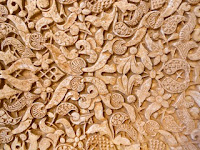GRANADA, SPAIN
Visiting El Alhambra was a highlight of our trip to Spain and of our whole European adventure so far. Apparently, El Alhambra is the most visited site in Spain—receiving over 2 million visitors every year. It’s an imposing and beautiful ancient city built in the 14th century within the Andalucian city of Granada, which is also several hundred years old and contains an old Muslim quarter called the “Albaicin.”
Visiting El Alhambra was a highlight of our trip to Spain and of our whole European adventure so far. Apparently, El Alhambra is the most visited site in Spain—receiving over 2 million visitors every year. It’s an imposing and beautiful ancient city built in the 14th century within the Andalucian city of Granada, which is also several hundred years old and contains an old Muslim quarter called the “Albaicin.”
 Purchasing tickets for our visit proved to be surprisingly difficult. We were warned to buy them ahead of time to avoid long lines at the entrance, so I tried several times to order them on the internet site but my credit card wasn’t accepted. I called and was put off by the operator who said there were no English speaking agents available until the next day. I called again and was disconnected twice. We tried to order tickets at the tourist information center in Seville and were again denied. Finally, on the way to Granada we stopped at a town twenty kilometers away and Lily used her brilliant Spanish to find out that the Caixa Bank sold tickets through its ATM machine. My first time at the ATM again denied my credit card, but it did accept a debit card the second time through. Whew! I’m glad our tour proved more than worth the trouble.
Purchasing tickets for our visit proved to be surprisingly difficult. We were warned to buy them ahead of time to avoid long lines at the entrance, so I tried several times to order them on the internet site but my credit card wasn’t accepted. I called and was put off by the operator who said there were no English speaking agents available until the next day. I called again and was disconnected twice. We tried to order tickets at the tourist information center in Seville and were again denied. Finally, on the way to Granada we stopped at a town twenty kilometers away and Lily used her brilliant Spanish to find out that the Caixa Bank sold tickets through its ATM machine. My first time at the ATM again denied my credit card, but it did accept a debit card the second time through. Whew! I’m glad our tour proved more than worth the trouble. We started early from our hotel to climb the hill toward the Alhambra in the frosty morning chill. At the entrance gate, we were among a small knot of tourists renting audio guides. As we strolled through the ruins of the old military fort—the alcazaba—and climbed the stone towers for panoramic views across the hills and back down on Granada.
Then we walked over for our timed entrance to the Nasrid Palaces. These are the residences of the last Muslim dynasty in Spain, which was finally pushed out by the Christians in the 15th century--Queen Isabella and King Ferdinand. I’m glad we visited Granada after Seville, for as impressive as found the Real Alacazar, the Alhambra eclipses its grandeur and scope. Our trip was planned to begin in Morocco in order to understand the roots of Moorish architecture in Spain, although we learned that there was actually a cross-fertilization of styles as waves of immigration moved back and forth between the two cultures. The style of architecture at the Alhambra is called “Mudejar” named after the Arabs who stayed on in Granada after most of them in the rest of Andalucia had been driven back to Morocco.
At the palaces, we walked through room after room with archways, alcoves and niches carved with elaborate geometric designs, Arabic calligraphy and flowers—no animal or human figures are allowed in Muslim art. We examined the colored motifs in the tiles on the walls and floors and wondered what the palace must have looked like when the walls were painted with bright colors centuries ago. The whole scene was magnificent.
After touring the palace we visited a special exhibit about Owen Jones, the British architect and designer who researched and introduced Islamic art to the west during Victorian times. It’s fascinating to think about the currents of Islamic art and architecture have influenced not only Spain, but in the 19th century the Art Nouveau movement in France, Christopher Dresser and William Morris in Britain, and even perhaps indirectly the American Frank Lloyd Wright.
Beth
Beth




No comments:
Post a Comment